AH-CHOO!
A Dark Cloud Hovers
The end of May and early June is such a glorious time of year in the garden, with plants thoroughly leafed out yet still showing the exuberance of spring growth. (Those of you to the north of me, Zone 5 in New York’s Hudson Valley: your time will come. Y’all to the south: enjoy your camellias, southern magnolias, muscadine grapes, figs, and . . . all the plants I wish I could grow this far north.)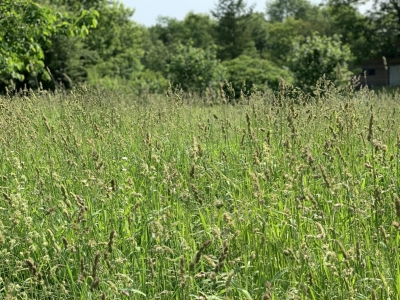 Yet even on the clearest, sunny day — and especially on that kind of day — a dark cloud hangs overhead. Hay fever, literally from hay that is, grasses; and nonliterally, from tree pollen.
Yet even on the clearest, sunny day — and especially on that kind of day — a dark cloud hangs overhead. Hay fever, literally from hay that is, grasses; and nonliterally, from tree pollen.
Every year the small white blossoms opening on multiflora roses signal that a sneeze season is on. That’s why this late spring allergy season is sometimes called “rose fever.” Rose is not the culprit; is just an easy to note phenological indicator of the progress of the season. Each plant awakens and starts its growth cycle in spring in response to a set accumulation of warm weather. Multiflora rose sends out a signal that the culprits are at work.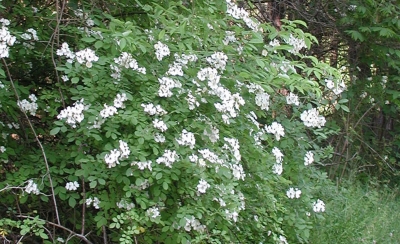 Multiflora rose puts on its show to attract pollinators, such as bees, which transfer pollen from one plant to the next. Hay fever is from airborne pollen blown about by wind, so the flowers of these allergen plants have no need to attract insect pollinators. The non-showy culprits this time of year are grasses and oaks.
Multiflora rose puts on its show to attract pollinators, such as bees, which transfer pollen from one plant to the next. Hay fever is from airborne pollen blown about by wind, so the flowers of these allergen plants have no need to attract insect pollinators. The non-showy culprits this time of year are grasses and oaks.
As with many other plant-related events, climate change is also leaving its mark on allergy seasons. Here in the northeast, the effect has been for the season to start earlier with a more intense peak. You would think that my multiflora rose indicator plants would keep apace with climate changes but my records, dating back for decades, indicates otherwise. (Daylength, which doesn’t change from year to year, is also sometimes a driver of plant or animal development through the season, and it can interact with temperature.)
No matter: I didn’t have to see a blooming multiflora rose the other day to know that my hay fever season was in full swing.
And the Culprits Are . . .
To at least make this allergy season more interesting, I thought I would look more closely at nearby flora and try to identify the specific culprit or culprits.
I can start by looking no further than the grassy meadow which comes to an abrupt stop at the close shorn lawn only about fifty feet to the south of my home.
With their small, nonshowy flowers, grass species are generally not easily identified. But I can narrow the field, figuratively, by species that are common in the Northeast and that I see now blooming in the meadow. The lineup, then, includes Kentucky bluegrass (Poa pratensis), sweet vernal grass (Anthoxanthum odoratum), and orchard grass (Dactylis glomerata).
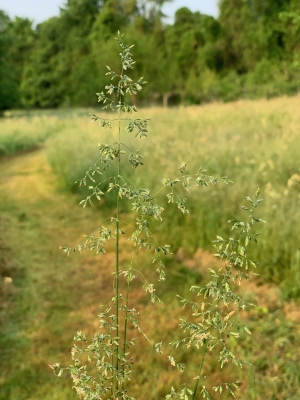
Kentucky bluegrass
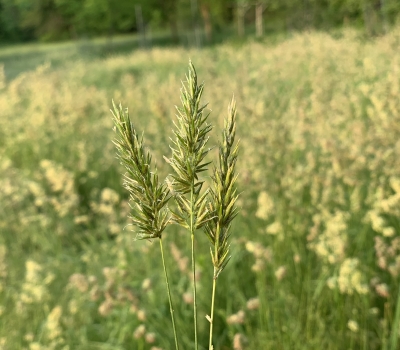
Sweet vernal grass

Orchard grass
According to the 1937 USDA Yearbook of Agriculture, most grasses bloom “most abundantly in early morning,” with a secondary flowering period for many of them in the afternoon. The bloom period might be delayed and prolonged in cloudy weather.
Although rain washes pollen out of the air, thunderstorms are another story. Thunderstorms are usually accompanied by winds, which lifts and blows pollen about, and the electrical charges induced by lightning throw add yet another layer of discomfort to the mix.
I just went out to the meadow to jiggle some seedheads of the culpable grasses. The pollen is heavy enough to travel only a few feet, even in a breeze.
Tree pollen is lighter than grass pollen and launches from greater heights. So I’m adding oak to the lineup. The two oaks most common around here are red oak (Quercus rubra) and pin oak (Q. palustris), with red oak, because of its bloom time being most culpable.
So there you have it: 3 grasses and an oak. They’re all nice plants, attractive and decorative. And, in the case of sweet vernal grass, also fragrant. If only they . . . or if only I . . .
I have my eye out for the flowering of catalpa trees and mountain laurel shrubs this time of year. Flowering of either of these plants are a signal that that relief is in sight that my hay fever season is over for the year. Again, these plants aren’t spilling any magical anti-hay fever concoctions into the air; they are merely phenological indicators of what’s happening with other, less conspicuous, flora and fauna.
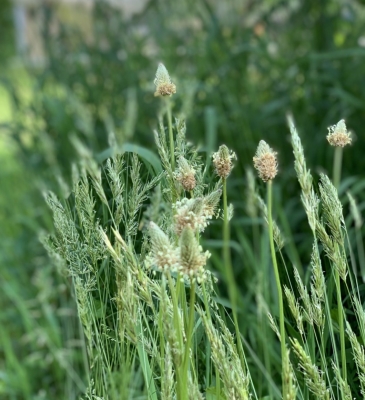
Plaintain, not a sneeze-inducer
DRIP WORKSHOP
See www.leereich.com/workshops for information about the upcoming drip irrigation workshop on June 30th.


After seeing what pollens look like under a microscope I was surprised I survived pollen season at all. My garden ferns and the local conifers get me and it’s common knowledge around my parts that it’s best to wait to wash the car until the “lime green event” is over.